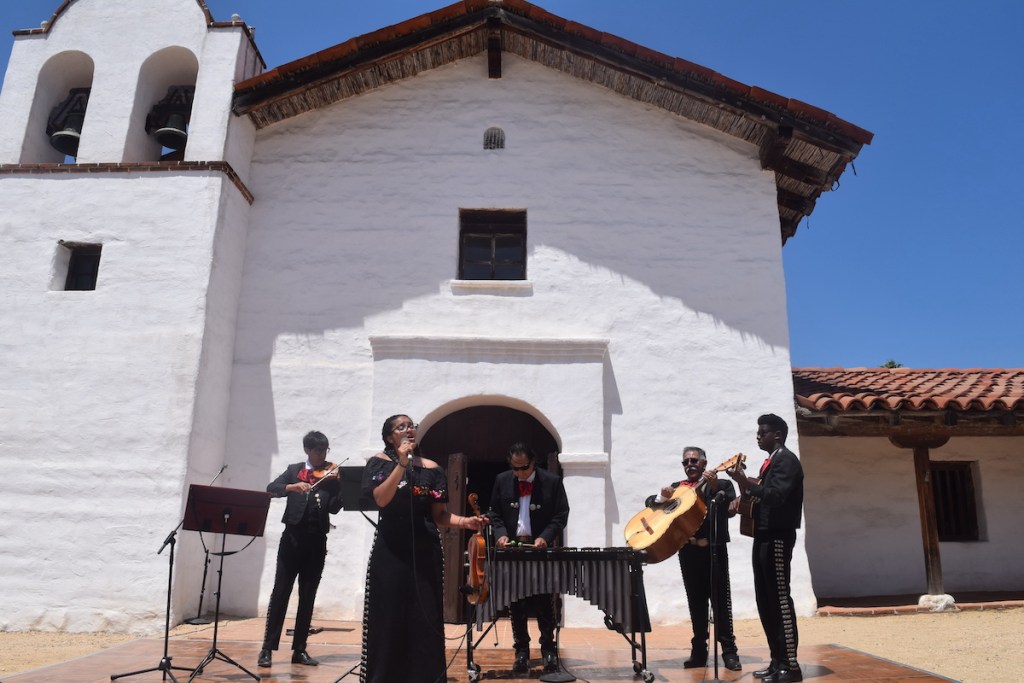The Santa Barbara Trust for Historic Preservation hosted the first-ever Community History Day on Sunday at El Presidio de Santa Bárbara State Historic Park, celebrating the city’s deep cultural history through dances, walking tours, and activities featuring local historians and artists.
El Presidio was open and buzzing with booths where the community could stop by and learn a little bit about the area’s vibrant history dating back thousands of years to when the Chumash called the area Syuxtun before it was colonized by the Spanish in the 1780s.
“We are here alive and well,” said LoryAnn Velez, Vice-Chair of the Barbareño Band of Chumash Indians. “And we are still here to tell the story.” Velez displayed early pigments of red ochre, yellow limonite, and white diatomaceous earth — which were made by the tribes native to the Central Coast — and demonstrated methods of weaving cordage using fibers from dogbane. The cordage, she said, could be used for everything from baskets to clothing. “It’s a demonstration of my heritage,” she said.
Throughout the day, Linda Vega Dance Studio and Mariachi Las Olas showed Santa Barbara’s Spanish and Mexican roots through dance and music, while Japanese drumming performances by Togen Daiko and Ojai O’Daiko shed a light on the lesser-known history of Nihonmachi — the city’s Japantown, which stood in the same place as El Presidio prior to WWII.
Also at the event was Santa Barbara Black Culture House, which has been holding events celebrating the city’s Black history and culture throughout the month, and local historian Michael Montenegro, whose Instagram account @ChicanoCultureSB provides a deep dive into Santa Barbara’s vibrant Latino community.
Sign up for Indy Today to receive fresh news from Independent.com, in your inbox, every morning.
“We have a cultura,” Montenegro said, “we have a community history, and we made this city what it is.” He added that there can often be a “façade of Eurocentrism” or Americanization of Santa Barbara, along with its reputation as a wine and tourism destination, but the city’s historical ties to Chicano activism run deep. He pointed to the community’s involvement with El Plan de Santa Barbara in 1969, the foundation of La Casa de La Raza, and the creation of the first-of-its-kind Movimiento Estudiantil Chicano de Aztlán (MEChA) club at UC Santa Barbara in the same year.
Nineteen-year-old filmmaker and recent Santa Barbara High School graduate Spenser Jaimes was fundraising for his second documentary on Sunday, a project which he says would tell the story of the 1824 Mission Revolt from the perspective of the native Chumash. His first short, Connected by Water, premiered in March at the Santa Barbara International Film Festival and was his first foray into telling the story of his Šmuwič-Chumash family connection with Limuw, now known as Santa Cruz Island.
“Since I was little, I’ve been interested in storytelling and learning about my people’s history and culture. As I’ve been growing up, I have seen how modern ways of storytelling, through books and media, are never done by our own people because we do not have access or the funds to do it ourselves,” reads his GoFundMe page, which has raised more than two-thirds of his $10,000 goal.
“Our people have our own accounts,” Jaimes told the Independent, “accounts that haven’t been told yet.” He hopes his next film can counteract the narrative of the revolt as “childish” and “unorganized,” and instead tell the story of a highly organized response to an act of violence against a young boy.
Jaimes hopes to have the documentary finished by the 200th anniversary of the event in 2024.
Support the Santa Barbara Independent through a long-term or a single contribution.

